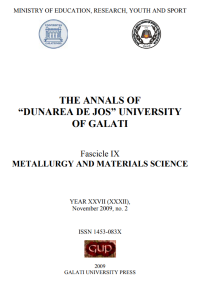Optimisation of Refractory Components of Sliding Gate Mechanism for Continuous Casting
Abstract
New design techniques have been developed to optimize refractory components of sliding gate mechanism for continuous casting of steel. The overall objective is to increase CC productivity as well as steel quality by using optimized refractory from ladle to tundish. These techniques allow the prediction of steel and refractory chemical interactions and, thus, steel chemistry evolution as well as build up and corrosion occurrence. The recent developments resulted in optimized refractories for sliding gate plates that meet the various continuous casting conditions. Furthermore, fracture mechanical measurements were established as a useful tool in the selection and development of slide gate refractories. The mechanical FEA evaluations take into account specific mechanical behavior of refractory components as well as high temperature evolution of their properties.
Downloads
References
[2]. Munteanu, V. - Steel flow control of continuous casted slabs using submerged entry nozzle exchange system for tundish – The annals of “Dunărea de Jos” University of Galati, Fascicle IX. Metallurgy and materials science, fascicle IX, No. 1-2007.
[3]. Vermeulen, Y., Simoes, J., Guillo, P., Di Dionato, A. - Advanced design of refractory components for continuous casting, Vesuvius International.
[4]. Bennenberg, N. - Wechselwirkungen Zwischen Feuerfestmaterial und Stahl und deren Einfluβ auf den Reinheitsgrad des Stahls, Stahl und Eisen, 1995, Vol. 115, No. 10, 75-82.
[5]. Singh, S.N. - Mechanism of Alumina Build-up in Tundish Nozzles during continuous Casting of Al-killed Steels, Met. Trans., 1974, Vol. 5, 2165-2178.
[6]. Duderstadt, G.C., Iyengar, R.K., Matesa, J.M. - Tundish Nozzle Blockage in Continuous Casting, Journal Of Metals, 1968, Vol. 20, No. 4, 89-94.
[7]. Vermeulen Y., Blanpain B., Wollants P. - Clogging Of Submerged Entry Nozzles, Steel Research, 2000, Vol. 71, No 10, 391-395.
[8]. Wiesel, M., Mira-Annika Mueller, M.A., Sherriff, R. - Refractories for Innovative Ladle Slide Gate Systems.
[9]. Höller, W., Lührsen, E., Wiesel, M. - Refractory Components for Control and Shrouding of Steel Flow, CN-Refractories, 1999, 3, 64-71.
[10]. Hasselman, D.P.H. - Unified Theory of Thermal Shock Fracture Initiation and Crack Propagation in Brittle Ceramics. Journal of the American Society, 1969, 52, 600-604.
[11]. Hasselman, D.P.H. - Thermal stress resistance parameters for brittle refractory ceramics: A compendium. Ceramic Bulletin, 1970, 49.
[12]. Chaudhuri, J., Mitra, S.K., Ghosh, B.N., Kamath, C.D., Swaminathan, K.S. - Thermal Stress behaviour of Magnesite slide Gate Plates, Presented Unified International Technical Conference on Refractories, New Orleans, U.S.A.1997, III, pp 1471-1481.
[13]. Glandus, J.C., Boch, P. -Main methods for thermal shock, Interceram.1984, 33, 33-37.
[14]. Krobath, M., Harmuth, H. - Bestimmung der Brucharbeit grobkeramischer feuerfester Werkstoffe bei hohen Temperaturen. KeramischeZeitschrift, 1994, 46.



